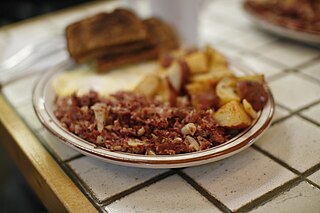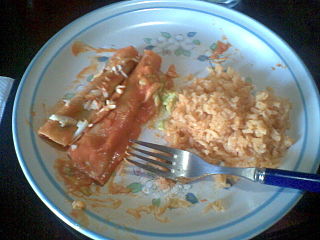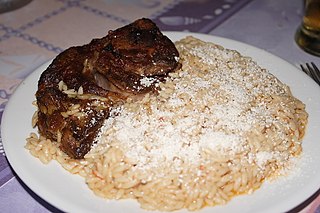Related Research Articles

Hungarian or Magyar cuisine is the cuisine characteristic of the nation of Hungary, and its primary ethnic group, the Magyars. Hungarian cuisine has been described as being the spiciest cuisine in Europe. This can largely be attributed to the use of their piquant native spice, Hungarian paprika, in many of their dishes. A mild version of the spice, Hungarian sweet paprika, is commonly used as an alternative. Traditional Hungarian dishes are primarily based on meats, seasonal vegetables, fruits, bread, and dairy products.

Goulash is a soup or stew of meat and vegetables seasoned with paprika and other spices. Originating in Hungary, goulash is a common meal predominantly eaten in Central Europe but also in other parts of Europe. It is one of the national dishes of Hungary and a symbol of the country.

Vindaloo or Vindalho is an Indian curry dish, originally from Goa. It is based on the Portuguese dish carne de vinha d'alhos. It is known globally in its British Indian form as a staple of curry house and Indian restaurant menus and is often regarded as a fiery, spicy dish. The traditional recipe uses pork, but alternative versions have been prepared with beef, mutton, prawns, chicken, lamb, vegetables and tofu.

Fried rice is a dish of cooked rice that has been stir-fried in a wok or a frying pan and is usually mixed with other ingredients such as eggs, vegetables, seafood, or meat. It is often eaten by itself or as an accompaniment to another dish. Fried rice is a popular component of East Asian, Southeast Asian and certain South Asian cuisines, as well as a staple national dish of Indonesia. As a homemade dish, fried rice is typically made with ingredients left over from other dishes, leading to countless variations. Fried rice first developed during the Sui Dynasty in China.

Hash is a dish consisting of chopped meat, potatoes, and fried onions. The name is derived from French: hacher, meaning 'to chop'. It originated as a way to use up leftovers. In the U.S. by the 1860s, a cheap restaurant was called a "hash house" or "hashery."

Pares, also known as beef pares, is a term for a serving of Filipino braised beef stew with garlic fried rice, and a bowl of clear soup. It is a popular food particularly associated with specialty roadside diner-style establishments known as Pares Houses. In recent years, it had also become a common dish served in small eateries called karinderyas or carinderias that serve economical meals for locals.
Romanian cuisine is a diverse blend of different dishes from several traditions with which it has come into contact, but it also maintains its own character. It has been mainly influenced by Turkish and a series of European cuisines in particular from the Balkans, or Hungarian cuisine as well as culinary elements stemming from the cuisines of Central Europe.

Beef bourguignon or bœuf bourguignon, also called beef Burgundy, and bœuf à la Bourguignonne, is a French beef stew braised in red wine, often red Burgundy, and beef stock, typically flavored with carrots, onions, garlic, and a bouquet garni, and garnished with pearl onions, mushrooms, and bacon. A similar dish using a piece of braised beef with the same garnish is pièce de bœuf à la bourguignonne.

Anticuchos are popular and inexpensive meat dishes that originated in the Andes during the pre-Colombian era, specifically in the Antisuyu region of the Tawantinsuyu. The modern dish was adapted during the colonial era between the 16th and 19th centuries and can now be found in Peru.

Dopiaza is the name of two separate dishes, one in the Greater Iran region and one in South Asia. It refers to a family of recipes, typically meat-based, that contain onions as a major ingredient. There are two alternative etymological explanations for its name.
- Onions are added at two stages of cooking: chopped or ground in the marinade/gravy, and as a garnish/topping, either pickled or crisply fried.
- The recipe uses onions and meat in a 2:1 ratio.
Bukharan Jewish cuisine is the traditional cuisine originating from the Bukharian Jewish community of Central Asia, who now mostly reside in Israel, and the United States.

Entomatadas are a typical Mexican dish made of a folded corn tortilla which has first been fried in oil and then bathed in a tomato sauce made from tomatoes, garlic, onion, oregano, chile serrano (optional) and salt. The recipes for the tomato sauce vary by cook. The tortilla can be filled with a number of different ingredients, however the most common are chicken, beef, cheese or beans. The chicken and beef have most often been pressure cooked so that the meat is tender and can be pulled apart with the fingers. More tomato sauce is poured on top of the filled tortillas and the dish is garnished with sour cream, shredded cheese and slices of white onion.

Giouvetsi, yiouvetsi, or youvetsi is a Greek dish made with chicken, lamb or beef and pasta, either kritharaki (orzo) or hilopites, and tomato sauce. Other common ingredients include onions/shallots, garlic, beef stock, and red wine. It is characteristically baked in a clay pot, a güveç, and served with grated cheese.

Mazamorra is the name for numerous traditional dishes from the Iberian Peninsula and Hispanic America.

Bulalô is a beef dish from the Philippines. It is a light colored soup that is made by cooking beef shanks and bone marrow until the collagen and fat has been melted into the clear broth. It typically includes leafy vegetables, corn on the cob, scallions, onions, garlic, ginger, and fish sauce. Potatoes, carrots, or taro can also be added. It is commonly eaten on rice with soy sauce and calamansi on the side. Bulalo is native to the Southern Luzon region of the Philippines, particularly in the provinces of Batangas and Cavite.

Balbacua, also spelled balbakwa or balbakoa, is a Filipino beef stew made from beef, collagen-rich beef parts, and various spices cooked for several hours until very tender. It is typically served with white rice or misua or miki noodles. It originates from the Visayan regions of the Visayas and Mindanao islands.

Nilaga is a traditional meat stew or soup from the Philippines, made with boiled beef or pork mixed with various vegetables. It is typically eaten with white rice and is served with soy sauce, patis, labuyo chilis, and calamansi on the side.

Paklay is two different Filipino braised dishes from the Mindanao and Visayas Islands characterized by julienned ingredients. They are eaten with rice or served as pulutan with alcohol.

Madurese cuisine is the culinary tradition of the Madurese people from Madura Island in Indonesia. This cuisine is particularly well-known in the neighboring areas of East Java, as well as on the south coast of Kalimantan. As a leading salt production center in the Indonesian archipelago, Madurese dishes are often saltier compared to Eastern Javanese cuisine, although with significant Javanese influences.
References
- ↑ ""Beef Dishes"".
- ↑ "Vanillerostbraten recipe" (in German).
- ↑ "Vanillerostbraten" (in German).
- ↑ "Vanillerostbraten" (in German). Archived from the original on 2009-04-15.